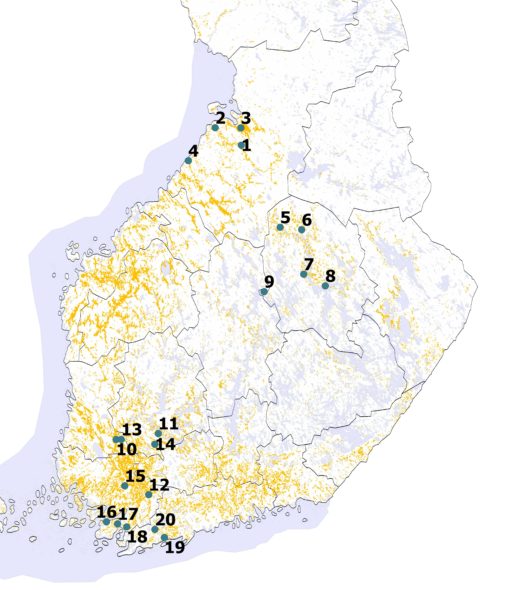We cooperate with the pilot farms to understand what sort of solutions would be both the most acceptable.
The pilot farms
Before building up the pilot farm network a survey on potential demonstration areas was carried out. After that a plan of the network was created. Potential pilot farmers were found with the help of info-events and news paper advertisements. There were ~ 50 farmers interested in becoming a pilot farmer, and 20 of them were chosen to the pilot farm network.
Facts about the pilot farm network:
- Total 20 farms
- Locations
- Northern region (4 farms)
- Eastern inland (5 farms)
- South-West inland (6 farms)
- Southern coastal (5 farms)

- Production lines
- Crop production (13 farms)
- for example cereals, potato, sugar beet, rape seed, pea, faba bean…
- Dairy cattle (3 farms)
- Beef production (1 farm)
- Pig production (3 farms)
- Crop production (13 farms)
- Range of farmers’ ages: 22-64
- Average size of farm’s total field area: 143 hectares/farm
What is done at the pilot farms?
We assemble data from the farms in many ways. Farmers will get an access to the data to develop their farming towards more profitable and environmentally sustainable. The development is carried out together with our research scientists.
Methods and materials:
- Parcel data
- Yield information, yield gaps
- Parcel characteristics: size, distance from the farm center, shape, slope, proximity to waterway, soil type and ownership
- Interviews
- Factors influencing decision-making
- Social acceptability
- Soil analyses (part of the farms)
- Economical calculations (part of the farms)
- Usage of the Land Use Optimization Tool
- Pilot version to be used at the pilot farms; farmers’ experiences and comments
